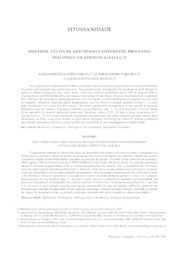Weather, cultivar and density-dependent processes influence on aphid in alfafa.
Weather, cultivar and density-dependent processes influence on aphid in alfafa.
Author(s): SILVA, A. de A. e.; VARANDA. E. M.; RASSINI, J. B.
Summary: It is important to understand the effects of weather, insect density and plant cultivar on insect abundance to predict and prevent crop production loss. The present work investigated the influence of such factors on aphid in alfalfa during one year (short term). Data was collected from September/1997 to August/1998 at Canchin Farm (CCPSE-EMBRAPA), São Carlos, State of São Paulo, Brazil. Weather conditions had, in general, little effect on the variation of aphid populations, but Therioaphis maculata abundance was negatively correlated to humidity. Moreover, high maximum temperatures and low levels of rainfall possible favored T. maculata high abundance on Crioula and P3 cultivars. Therefore, appropriate management of this species is required during hot and dry periods. Population variation of Acyrthosiphon spp., T. maculata and Aphis craccivora seems to be regulated by density dependent processes. Resistant cultivar CUF 101 had a lower abundance of T. maculata and A. craccivora and a narrower population variation than the other cultivars and may reduce their abundance on field. Long-term studies on population dynamics including the effect of climatic conditions and density-dependent factors on plant quality will contribute to pest management in alfalfa fields.
Publication year: 2007
Types of publication: Journal article
Observation
Some of Embrapa's publications are published as ePub files. To read them, use or download one of the following free software options to your computer or mobile device. Android: Google Play Books; IOS: iBooks; Windows and Linux: Calibre.
Access other publications
Access the Agricultural Research Database (BDPA) to consult Embrapa's full library collection and records.
Visit Embrapa Bookstore to purchase books and other publications sold by Embrapa.

